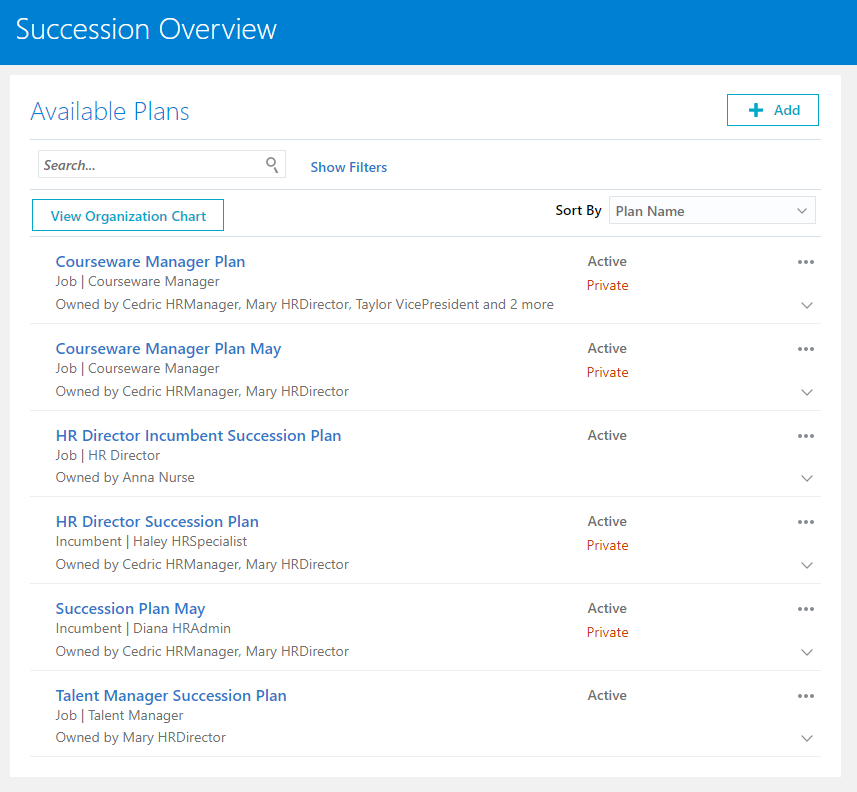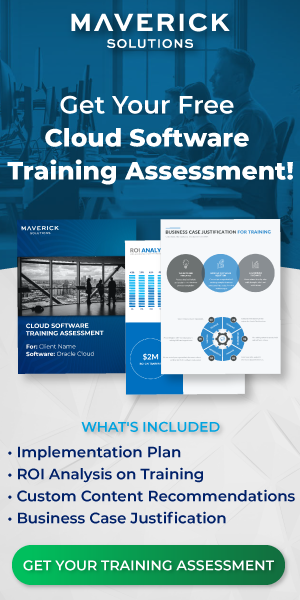Succession planning is the process in which employees are recruited, developed, and trained to fill a senior or key role within a company. To begin succession planning in Oracle HCM Cloud, you will need to navigate to the Succession Plans work area. From the Succession Plans work area, you can create or edit succession plans for the various senior or key roles within your company.
Succession planning is critical to your company’s long-term success. Without a proper succession plan in place, your company is at risk for unforeseen illnesses, accidents, pandemics or sudden vacancies. Succession planning ensures your company can react to change quickly, with the right people, in the right place. The following list details the 4 major benefits of succession planning:
- Succession plans is another form of insurance.
- Succession plans enable HR to create intentional training and development.
- Succession plans improve employee morale.
- Succession plans reduce recruitment costs.
Let’s break down the 4 benefits of succession planning before going over the basics of succession planning in Oracle HCM Cloud.
For help with succession planning in Oracle HCM Cloud, ask to see our Talent Management course in our Oracle HCM Cloud offering available with ENGAGE by Maverick. ENGAGE by Maverick is Maverick Solutions’ subscription-based training offering on all Oracle Cloud applications. Speak with one of our training experts today!
1. Succession plans is another form of insurance.
Your company is insured against natural disasters, like hurricanes and floods. Succession plans protect your company in much of the same way your insurance policies protect your company.
Succession plans protect your company from an employee in a senior or key role suddenly vacating their position. Employees might vacate their position by choice by retiring or taking their talents to a different company. Or your company might be in an unfortunate situation where a senior or key role has a vacancy due to an accident or illness.
When a role is suddenly vacated, it is imperative there are plans and systems in place to seamlessly transition another person into the role with as few interruptions to the company. Without a proper succession plan in place and without a logical successor in place to fill the vacancy, your company’s day-to-day business can be severely disrupted.
Succession plans enable your company to keep functioning well no matter the unforeseen circumstance.
2. Succession plans enable HR to create intentional training and development.
The employees in senior or key roles have the necessary skills, talents, and competencies to fill their role. This makes it easier to create a curriculum of goals and competencies for possible successors to complete or achieve in order to seamlessly promote to the senior or key role.
For example, Molly is a manager at her company. She has 8 hard skills and 9 soft skills that she regularly uses in her day-to-day responsibilities. Whoever succeeds Molly must be proficient in the 8 hard skills and 9 soft skills. Identifying these skills allow the learning and development team to create training programs that foster the right skills in employees.
Once required and desired hard and soft skills are identified, managers or HR can identify how proficient the employee is in the skill. This enables HR to identify and address any competency gaps a possible successor has.
Let’s take a look at an example of how succession planning can lead to intentional training and development.
Lucy has indicated her desire to promote to a key role. Additionally, Lucy has shown more motivation than her peers, and she has worked to become more proficient in the appropriate skills for the role. If your company knows that Lucy has 7 of the 8 hard skills and 7 of the 9 soft skills required for a key role, your learning and development team can intentionally groom Lucy to learn the other 1 hard skill and 2 soft skills to promote to the role.
For help with succession planning in Oracle HCM Cloud, ask to see our Talent Management course in our Oracle HCM Cloud offering available with ENGAGE by Maverick. ENGAGE by Maverick is Maverick Solutions’ subscription-based training offering on all Oracle Cloud applications. Speak with one of our training experts today!
 [/vc_column_text][vc_column_text]
[/vc_column_text][vc_column_text]
3. Succession plans improve employee morale.
Succession planning allows your company’s HR team to create intentional training and development courses, but it also improves employee morale.
Take our example from above for instance. Because Lucy has indicated her desire to promote to a key role and because of her hard work, HR can groom her by teaching Lucy the appropriate skills to promote to the role. Lucy feels her hard work has been noticed and appreciated, and she feels like the company is investing into her the way she is investing into the company.
Succession planning helps both the company and the employees. Employees see the concrete ways in which a company is helping them grow and advance their career. And because the employees know their career progression, they are loyal to the company. Additionally, succession planning helps the company stay prepared for any unforeseen change.
4. Succession plans reduce recruitment costs.
Hiring a reputable HR firm to find external candidates can cost a company hundreds of thousands of dollars annually. Additionally, an external hire takes longer to train because they have to learn the company’s unique business processes, but because the external hire has to learn the company’s culture, mission, and vision.
Promoting from within saves the company from spending hundreds of thousands of dollars to a reputable HR firm. And it allows the employees who are currently in the role to devote time to complete a data transfer to their successor.
For help with succession planning in Oracle HCM Cloud, ask to see our Talent Management course in our Oracle HCM Cloud offering available with ENGAGE by Maverick. ENGAGE by Maverick is Maverick Solutions’ subscription-based training offering on all Oracle Cloud applications. Speak with one of our training experts today!
Succession Planning in Oracle HCM Cloud
Your company can use the Succession Plans work area to create succession plans in Oracle HCM Cloud. From the Succession Plans work area, you can see all of the available succession plans at your company. The following screenshot displays an example of the Succession Plans work area:

From the Succession Plans work area, you can view the following information:
- The owner(s) of each succession plan
- Succession plan type
- Succession plan name
- Status
- Number of active candidates
- Number of interim candidates
- Number of ready candidates
- Number of candidates with 1 to 2 years readiness
- Number of candidates with 3 to 4 years readiness
- Number of candidates with no readiness available
You can click on the succession plan name to view or edit the succession plan.
Note: When you look at a succession plan from the Succession Plans work area, you can only see the number of candidates. You cannot see who each candidate is. You will need to click on the succession plan to see who all the candidates are. When you click on the succession plan, you can view which candidates are ready and which candidates are not ready. For the candidates who are not ready, you can view when they will be ready.
Creating Succession Plans
You can create new succession plans from the Succession Plans work area. Alternatively, you can create a succession plan from the organization chart or from a talent review meeting. You can build succession plans using the following three plan types:
- Job: Your company will use this plan type to identify candidates for a job. There may be multiple openings for this job. You will need to associate the plan with the job or job code.
- Position: Companies use job succession plans for high-level positions, such as a Chief Sales Officer (CSO) or Chief Revenue Officer (CRO), or for other roles.
- Incumbent: Your company will use this plan type to create a succession plan to replace a specific person.
Succession plan owners can add candidates to plans in either of the following methods:
- Manually searching and adding the person to the plan.
- Using the Find Best Fit feature to let the application search for the employees whose skills line up with the role’s requirements.
Still have more questions? You can access detailed walkthroughs of the Oracle HCM Cloud offering and more with ENGAGE by Maverick. For example, we have step-by-step walkthroughs that can guide you and your team through creating a job succession plan, managing succession plans, and creating an incumbent succession plan. You can also access content that covers talent review meetings and interactive tutorials that guide users through conducting a talent review meeting. We also have content across the full Oracle HCM Cloud suite, such as Absence Management, Benefits, Compensation, Global Human Resources, Payroll, Recruiting, Talent Management, and Time and Labor.
ENGAGE by Maverick is Maverick Solutions’ subscription-based training offering on all Oracle Cloud applications. It is fully customizable, comprehensive, and available 24/7/365. We also have customizable, interactive tutorials that guide your team through complex business processes. If you want to learn how Maverick Solutions can fit into your organization’s current or future Oracle projects, speak with one of our training experts today!
The article was written for Oracle release 21A. Due to the nature of Cloud software and updates, this article may no longer be accurate. If you would like access to the most up-to-date version, please reach out to our team to learn more.



